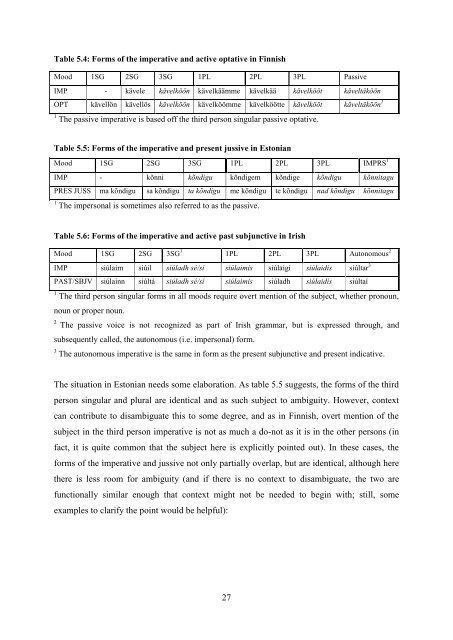The function of non-canonical imperatives in the languages of Europe
The function of non-canonical imperatives in the languages of Europe
The function of non-canonical imperatives in the languages of Europe
Create successful ePaper yourself
Turn your PDF publications into a flip-book with our unique Google optimized e-Paper software.
Table 5.4: Forms <strong>of</strong> <strong>the</strong> imperative and active optative <strong>in</strong> F<strong>in</strong>nish<br />
Mood 1SG 2SG 3SG 1PL 2PL 3PL Passive<br />
IMP - kävele kävelköön kävelkäämme kävelkää kävelkööt käveltäköön<br />
OPT kävellön kävellös kävelköön kävelköömme kävelköötte kävelkööt käveltäköön 1<br />
1 <strong>The</strong> passive imperative is based <strong>of</strong>f <strong>the</strong> third person s<strong>in</strong>gular passive optative.<br />
Table 5.5: Forms <strong>of</strong> <strong>the</strong> imperative and present jussive <strong>in</strong> Estonian<br />
Mood 1SG 2SG 3SG 1PL 2PL 3PL IMPRS 1<br />
IMP - kõnni kõndigu kõndigem kõndige kõndigu kõnnitagu<br />
PRES JUSS ma kõndigu sa kõndigu ta kõndigu me kõndigu te kõndigu nad kõndigu kõnnitagu<br />
1 <strong>The</strong> impersonal is sometimes also referred to as <strong>the</strong> passive.<br />
Table 5.6: Forms <strong>of</strong> <strong>the</strong> imperative and active past subjunctive <strong>in</strong> Irish<br />
Mood 1SG 2SG 3SG 1 1PL 2PL 3PL Autonomous 2<br />
IMP siúlaim siúil siúladh sé/sí siúlaimis siúlaigí siúlaidís siúltar 3<br />
PAST/SBJV siúla<strong>in</strong>n siúltá siúladh sé/sí siúlaimis siúladh siúlaidís siúltaí<br />
1 <strong>The</strong> third person s<strong>in</strong>gular forms <strong>in</strong> all moods require overt mention <strong>of</strong> <strong>the</strong> subject, whe<strong>the</strong>r pronoun,<br />
noun or proper noun.<br />
2<br />
<strong>The</strong> passive voice is not recognized as part <strong>of</strong> Irish grammar, but is expressed through, and<br />
subsequently called, <strong>the</strong> autonomous (i.e. impersonal) form.<br />
3 <strong>The</strong> autonomous imperative is <strong>the</strong> same <strong>in</strong> form as <strong>the</strong> present subjunctive and present <strong>in</strong>dicative.<br />
<strong>The</strong> situation <strong>in</strong> Estonian needs some elaboration. As table 5.5 suggests, <strong>the</strong> forms <strong>of</strong> <strong>the</strong> third<br />
person s<strong>in</strong>gular and plural are identical and as such subject to ambiguity. However, context<br />
can contribute to disambiguate this to some degree, and as <strong>in</strong> F<strong>in</strong>nish, overt mention <strong>of</strong> <strong>the</strong><br />
subject <strong>in</strong> <strong>the</strong> third person imperative is not as much a do-not as it is <strong>in</strong> <strong>the</strong> o<strong>the</strong>r persons (<strong>in</strong><br />
fact, it is quite common that <strong>the</strong> subject here is explicitly po<strong>in</strong>ted out). In <strong>the</strong>se cases, <strong>the</strong><br />
forms <strong>of</strong> <strong>the</strong> imperative and jussive not only partially overlap, but are identical, although here<br />
<strong>the</strong>re is less room for ambiguity (and if <strong>the</strong>re is no context to disambiguate, <strong>the</strong> two are<br />
<strong>function</strong>ally similar enough that context might not be needed to beg<strong>in</strong> with; still, some<br />
examples to clarify <strong>the</strong> po<strong>in</strong>t would be helpful):<br />
27
















